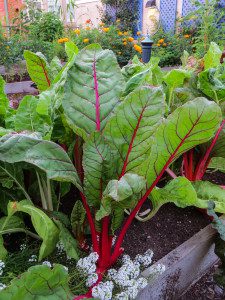Apr. 10 column: Shady vegetable gardens

Sometimes I feel a bit guilty. I’ve got a great sunny spot for my vegetable garden. Yet I know that many of you aren’t so lucky in that regard. You might be dealing with partly shady vegetable gardens, or perhaps thinking you can’t even grow veggies in that spot.
That’s not necessarily the case, however. In my garden column today, I write about the types of crops you can grow and strategies you can use to get produce from your yard.
 For some reason, though, my column is not available on The Spokesman-Review’s online edition, so the text of my column is below. I hope it will inspire you to get a garden going this spring and would love to hear how it does. Just drop me a note at Susan@susansinthegarden.com.
For some reason, though, my column is not available on The Spokesman-Review’s online edition, so the text of my column is below. I hope it will inspire you to get a garden going this spring and would love to hear how it does. Just drop me a note at Susan@susansinthegarden.com.
And remember, gardening is a learning process. Everyone gains experience through trial and error. So if at first you don’t succeed, try try again! :o)
Growing Veggies Possible Under Less-Than-Ideal Conditions
by Susan Mulvihill
Most vegetable gardeners are blessed with gardens that get plenty of sunshine. Then there are folks who would like to grow their own produce but know their garden space has a bit too much shade.
If you’re in the latter group, don’t despair. While it’s true that most vegetable crops perform best if they get six hours of sunlight or more daily, you still have plenty of options.
Start by taking a look at the pattern the sun takes through your yard over the course of a few days. That will help you find the most ideal spot for a garden, even if it’s going to be the size of a postage stamp.
Are there trees or structures that cast shadows? And if a tree is the culprit, is it feasible to remove a few branches?
Garden sheds or house walls aren’t always a problem, however. Oftentimes, light-colored walls that are hit by the sun will reflect extra light that your garden can benefit from. If the wall adjacent to your garden spot is dark, and you really want to grow veggies, consider painting it white to take advantage of this.
Once you’ve sorted out the maximum amount of sunlight you can squeeze out of a spot in your yard, it’s time to decide what to plant. Crops such as tomatoes, peppers, eggplants, squash, melons and cucumbers require a lot of sunshine to bloom and set fruit. However, you can still grow vegetables in shady gardens by choosing crops that will tolerate those conditions.
Leafy salad greens are very forgiving. Options include spinach and lettuce varieties that range in color from green to speckled to deep burgundy. Think how pretty that would be, both in your garden and your salad bowl.
But it doesn’t end there. Chinese cabbage, Swiss chard, pak choi, mizuna, kale and beets are all worth experimenting with. You might even consider planting onion seeds and harvesting the plants as scallions (green onions) while they’re young.
Herbs are another option. You can easily grow parsley, mint, thyme, sage or rosemary in dappled sunlight.
One more idea is to use large, wheeled pots to grow some sun-loving vegetables. That way, you can follow the sun on your deck or patio. Self-watering containers that have water reservoirs are ideal since regular containers tend to dry out quickly. In addition to keeping your plants hydrated, they cut down the amount of effort needed to tend your garden.
Another way to take advantage of your garden’s light conditions is by growing a few crops vertically. There might be extra sunshine above your garden plot that crops can benefit from by growing them on a trellis or other type of vertical support.
Some suggestions are peas, pole beans or even a vining summer squash. Last summer, I grew ‘Trombetta di Albenga’ — which had trombone-shaped zucchini — and they were absolutely delicious. I supported the plants with a 4-foot by 8-foot sheet of concrete-reinforcing wire fastened to some metal fence posts and it worked great. Another vining zucchini variety is ‘Zucchetta Rampicante’.
And while we’re on the subject of vertical gardening, remember that your veggie garden doesn’t have to be restricted to a separate growing space in your yard. If you’ve got an arbor located in a sunny spot, consider using it to grow pole beans, cucumbers, small melons or petite winter squash like ‘Delicata’.
This season, see if you can turn your light-challenged garden into a productive one.
